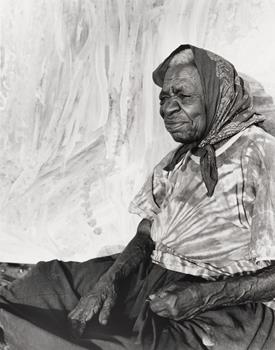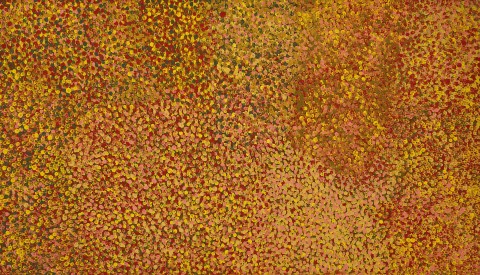MERNE (EVERYTHING), 1991
EMILY KAME KNGWARREYE
synthetic polymer paint on linen
121.5 x 212.0 cm
bears inscription verso: artist’s name and Delmore Gallery cat. 1W29
Commissioned by Delmore Gallery, via Alice Springs
Barry Stern Gallery, Sydney
Private collection, Sydney
Sotheby’s, Sydney, 16 August 1999, lot 75 (as ‘Merne (Food) Everything’)
Private collection, Brisbane
For two related works executed at the same time and of the same style, see Kame-Summer Awelye I, 1991, and Merne Artherrke, 1991, held in private collections, illus. in Neale M. (ed.), Utopia; The Genius of Emily Kame Kngwarreye, National Museum of Australia and The National Museum of Art, Osaka, 2007, pp. 134 – 135 cat. D-20 & D-21
This painting is accompanied by a certificate of authenticity from Delmore Gallery.
220043.jpg

A response to the everchanging landscape of her traditional homelands at Alhalker (Alalgura), north-east of Alice Springs, the paintings of Emily Kngwarreye record her acute observation, often in minute detail, of the shifting fluctuations in the state of the flora around her, alerting her to the readiness of bush food or medicinal plants. Judith Ryan notes that, ‘clearly Emily Kngwarreye was a mark-maker extraordinaire…. she ventured further with masses of dots and marks, making intimate and grand gestures layering and intensifying the dots to the exclusion of graphic elements’1 and here in Merne (Everything) 1991, layers of olive, yellow, dusky pink, purple and grey dots – in many places applied by the artist using her fingers – produce fields-of-dots that faithfully evoke the colours of her country after early-summer rains when the first new growth appears through the parched earth after months of dryness. The black ground may be seen as the spread of the roots of Emily Kame Kngwarreye’s totemic yam plant underground, together with the spread of ancestral forces through the earth.
Kngwarreye’s paintings were constructed of various elements that over time were either augmented or eliminated from the surface of the canvas. Underlying grids structure the compositions, sequences of dots aligned between or over dots, dashes and linear marks, meandering lines and areas of dots applied on dots that allow a build-up of colour. These elements constitute the artist's lexicon and are used separately or in varying combinations thus allowing her work to evolve and be constantly fresh. Her early works were predominantly characterised by dots, an integral stylistic element in Kngwarreye’s painting and whilst dots have become an identifiable hallmark of contemporary Indigenous painting, ‘few desert artists, either men or women have used the dot mark as innovatively as Emily.’2 The range of her dots vary from fine to coarse, light to heavy sometimes singular and individual, other times multiple dots are overlaid and combined to form lines or representations of seed pods or any of the myriad of plants that bloom at this time of year.
During the 1990s, Emily Kngwarreye emerged as one of Australia's leading painters and her works were sought after on an unprecedented scale. Kngwarreye became nationally and internationally recognised for the many stylistic shifts she effortlessly adopted which allowed her painting to evolve intuitively in the way she responded to her specific cultural experience. These striking interpretations of country, not only challenged, but irrevocably changed, preconceived notions of Indigenous art.
1. Ryan, J. cited in Isaacs, J. et al., Emily Kngwarreye Paintings, Craftsman House, Sydney, 1998, p. 77
2. Christopher Hodges quoted in Neale, M. et al., Utopia: The genius of Emily Kame Kngwarreye, The National Museum of Art, Osaka, 2008 p. 113
CRISPIN GUTTERIDGE
